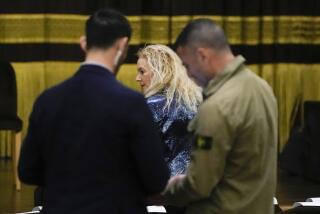Polish City’s Teen Curfew Stirs Passions
- Share via
RADOM, Poland — Until this year, the worst case of lawlessness in memory in this city of 230,000 occurred about 20 years ago, when factory workers rioted after a rise in meat prices. Police were encouraged to smash heads, and, by sunup the next morning, four laborers lay dead in the streets and 2,000 had been summarily jailed.
Aside from that brutal episode, Radom has long been a quiet, unexceptional, mid-size Polish city, known not for seething slums or a soaring crime rate but for its humming tanneries and Kalashnikov assault-rifle factory. Certainly, it would have occurred to very few here that the local teenagers constituted a menace to the common weal.
Lately, though, Radom has attracted the attention of European human rights groups and become a topic of national debate. Does the city represent an enlightened example in the battle to save Poland’s wayward young? Or is its crime-fighting method of choice--a curfew--a vestige of the police state, a sign that post-Communist officials here remain all too willing to uncuff the police, even when no one has committed a crime?
“I’ve worked here for 20 years, and I can remember only one case where one teenager killed another,” says Hieronim Glaz, the supervisor of the local juvenile lockup, where police can stash troublesome minors for 48 hours. “At that time, we thought it was totally out of this world.”
Brawl Shocks City
Last New Year’s Eve, however, the people of Radom were shocked when one high school student beat another to death in a barroom brawl. And then, in March, the unthinkable happened again: Two teenagers strangled a 14-year-old boy with an electric cord because they coveted his stylish Adidas gym shoes and sweatsuit.
Finally, in April, when a local 16-year-old fatally bludgeoned his middle-aged neighbor after the neighbor accused him of vandalizing a doorbell, Radom swung into action.
Now, the city police are supposed to demand identification from any young person they find on the streets between 11 p.m. and 5 a.m. Those under 18 may be taken to Glaz’s makeshift jail and booked. The cops then pass the information to the town youth advocate, who calls the kids’ parents and invites them to his office for tea and consultations.
Just so much wrist-slapping, one might think, given the rough stuff the youth of Radom seem to go in for these days. And with cities across America experimenting with curfews of their own, one wouldn’t think a nighttime clampdown in Radom would be the stuff that human rights advocates’ nightmares are made of.
But this is Poland, a former Eastern Bloc country where civil liberties arrived only after 40 years of assembly-line Communist repression. Until recently, having one’s name entered in a police ledger here could mean being blacklisted, or even beaten up in a secret cell.
For Andrzej Rzeplinski, a founding member of the Helsinki Foundation--a respected research group that monitors the progress of human rights in Poland--the question of whether a curfew is justified is a no-brainer.
“It’s a totalitarian way of thinking,” he says.
But seated at a desk in his cramped, coal-heated office on a snowy morning in Radom, Wlodzimierz Wolski does not look like much of a totalitarian thought policeman from the bad old days. A gym teacher in Communist times, Wolski is now Radom’s youth advocate, charged in the new, democratic order with safeguarding the rights of minors in his city.
It was Wolski who came up with the curfew idea--and he did so, he says, because after the unprecedented series of killings, frightened young people and their parents lined up to beg for help. They wanted to feel safe again.
Wolski simply couldn’t believe it when some Polish newspapers covered his save-the-children program with headlines such as “Martial law in Radom,” along with scary photos of burly cops in dark jackets.
“In Poland, words like ‘martial law’ and ‘curfew’ cause fury in people,” he says. “People don’t associate them with anything good. Now the kids in Radom think somebody is trying to hurt them.”
And hurting people, says Wolski, is the last thing he wants to do. When the parents of late-night wanderers come to his office, he says, he watches closely for signs of drinking, spousal abuse or other domestic unpleasantness that might be driving the children into the streets.
The purpose, he says, is to get alcoholic parents into treatment, to reach out to battered wives, even to offer cash assistance and help people find jobs.
Until the civil libertarians jumped in, Wolski had become something of a minor national hero, basking in the attention of mayors and youth agencies across Poland. Dozens of officials had contacted his office, he says, to ask how they too could impose curfews and clear their streets of the unruly young. In Warsaw, specialists began studying ways to implement a national version. Polls showed that more than 90% of respondents liked the idea.
Wolski, meanwhile, could proudly rattle off police statistics suggesting that his city has, in fact, sharply reduced youth crime.
“Until now, the police stopped teenagers only if they had done something really bad, like drinking alcohol or breaking into a car,” he says. “Now, every underage person on the street at night is seen as a threat and is asked what they are doing.”
Every Teen a Threat
It’s precisely this line of thinking--every teenager a threat--that has set alarm bells ringing at the Helsinki Foundation, whose intellectuals and scholars worked bravely from underground during the Polish martial-law years to document and publicize all manner of abuse that took place in the name of law enforcement.
“The Polish law does not allow detentions of people by group,” says the foundation’s Rzeplinski. “You cannot detain all teenagers, any more than you can detain all Jews, all bald people or all cyclists.”
Although the Helsinki Foundation says it hasn’t yet received any formal complaints from young people in Radom, it has offered to file suit at the European Court of Justice on behalf of any Radom minor who wants to challenge his or her detention. It has also urged Wolski to come in and discuss ways to make his curfew compatible with human rights, but Wolski refuses to make such an appointment.
“An average, normal child, who has not committed any misdemeanors, should not be put into the juvenile lockup,” says Elzbieta Czyz, coordinator of the Helsinki Foundation’s children’s program. “A person who has never been there cannot imagine what it is like. Some of these juvenile lockups are even worse than the adult centers. There are bars on the windows. The teenagers are searched, which is unjustified. They have to take off their clothes and take a bath. And then, irrespective of the time of day, they have to put on pajamas.”
A tour of Radom’s juvenile lockup reveals that Czyz is right about the barred windows and daytime pajamas. In a room furnished with a pingpong table and a television set sits Przemyslaw Binder, 16, who was brought in for beating up his father.
The undignified baggy PJs, with their bold blue and white stripes, do give Binder the comical air of a cartoon escapee from a chain gang. But far from resenting his jailers, Binder says he thinks Poland’s post-Communist state needs to do even more of this sort of thing.
“In the past, when the penalties were stricter, there were fewer crimes,” he says, echoing a common complaint. “Now, in the prisons, people have television sets, exercise rooms, and pork chops for lunch, and they realize they are better off in prison than at home.”
As for Radom’s curfew, Binder applauds the idea.
“I’m being treated very well here,” he says. His biggest fear, it turns out, is that after his 48 allotted hours in custody are over, he will have to go home and face his father.
“He’ll just kick me out, and it’s really freezing outside,” he worries.
Painful Changes
Social workers and police alike say it’s Poland’s transformation to a market economy that is making young people so brutal: Parents are too busy working to teach moral codes; the old Communist sports gyms and scouting groups have vanished; and many young people, unsure what democracy is, assume it means the right to do anything, any time.
Again and again, analysts here also cite the sudden influx of foreign pop culture--everything from kung fu videos to rap music--that has hit Poland’s formerly sheltered youth like a gut punch.
“Generally, there’s a lot of aggression in the movies,” says Barbara Kalicka, a youth crime specialist with the Polish national police force. “But we police can’t say anything about this because we’re still not loved in Poland.”
Indeed, today’s Polish police are often veterans of the tough, Communist “political militias,” and some show signs of uncertainty about where to draw the lines of their authority.
“At soccer matches, you can see the police running away [from brawls] because they don’t know to what extent they can use force,” says Edmund Wnuk-Lipinski, chairman of the Institute of Political Studies of the Polish Academy of Sciences.
In Radom, however, police officer Wlodzimierz Wujek says he is sure about one thing: “Checking somebody’s ID is perfectly legal.”
Wujek and his partner, Tadeusz Blach, a 17-year veteran, are charged with enforcing Radom’s curfew on this night, but despite hours of cruising in their navy-blue patrol van, most of the action seems to involve not brutish teens but elderly drunks.
“When they introduced this program, the young people really disappeared,” explains Blach, wheeling the van around a corner and onto a dim and nearly deserted street. “This is the main street of Radom, and you can see how many people there are. If nobody is walking on the main street, then who are we going to find on the side streets?”
Finally, though, two slender shadows skitter in front of the van. Blach does a U-turn and pulls up alongside a short young man in a leather jacket and a taller one in a parka. Wujek opens the passenger-side window and demands their identification.
“But we’re just going home,” protests the one in leather. “There was no bus, and we had to walk.”
“There’s a night bus that you could have taken,” Wujek retorts, demanding their ID cards.
Questions follow. What were the boys doing earlier in the evening? (Visiting a girlfriend.) Did they drink anything? (No.) Are they still in school? (No.) How old are they?
When Wujek hears that they are 16, he sighs. “Instead of studying, you guys are out on the streets,” he says. “I don’t know what to do with you. I guess I’ll take you to the police station.”
Off goes the van, with the two boys sitting wide-eyed in the back behind heavy wire mesh.
“In a case where they’re only 16 but don’t go to school anymore, I think we should check what kind of families they come from,” says Blach, at the wheel. “We’ll make sure they’re not already on some kind of list, and then we’ll call the parents and tell them to come get them.”
More to Read
Sign up for Essential California
The most important California stories and recommendations in your inbox every morning.
You may occasionally receive promotional content from the Los Angeles Times.










